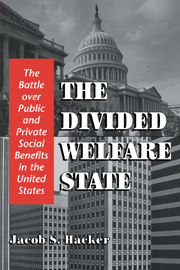Book contents
- Frontmatter
- Contents
- List of Tables
- List of Figures
- Preface
- Part I The American Welfare Regime
- Part II The Politics of Public and Private Pensions
- Introduction
- 2 Connected at Birth: Public and Private Pensions Before 1945
- 3 Sibling Rivalry: Public and Private Pensions After 1945
- Part III The Politics of Public and Private Health Insurance
- Part IV The Formation and Future of the American Welfare Regime
- Appendix
- Notes
- Index
3 - Sibling Rivalry: Public and Private Pensions After 1945
Published online by Cambridge University Press: 05 June 2012
- Frontmatter
- Contents
- List of Tables
- List of Figures
- Preface
- Part I The American Welfare Regime
- Part II The Politics of Public and Private Pensions
- Introduction
- 2 Connected at Birth: Public and Private Pensions Before 1945
- 3 Sibling Rivalry: Public and Private Pensions After 1945
- Part III The Politics of Public and Private Health Insurance
- Part IV The Formation and Future of the American Welfare Regime
- Appendix
- Notes
- Index
Summary
After World War II, private pensions began to enter a new phase of expansion, with labor-oriented plans beginning to appear alongside the company-initiated programs of the past. This development was driven less by tax policy than by the changing strategies of organized labor and the evolving context of collective bargaining. American unions were pulled into conflict over private social protection by the internal exigencies of labor organization, by the continued failure of Congress to expand public programs, by the concerted effort of conservatives to cripple unions' capacity, and, paradoxically, by the actions of liberals in Congress, the White House, and the courts, who found themselves siding with organized labor in defense of private benefits toward which they were otherwise ambivalent or hostile. When the struggle was over, American labor had carved out a new role in the private pension system and, in the process, firmly institutionalized it.
The rise of labor-negotiated plans had two ironic consequences. First, it tied the labor movement closely to the very private system of employment-based benefits that it had once criticized as an inadequate substitute for public social insurance. In doing so, negotiated pensions dampened and redirected, though certainly did not eliminate, the broader demands of the labor movement for public social insurance. Second, and cutting in the other direction, the entry of labor into the pension field made business leaders more willing to support the broadening of Social Security to offset the cost of negotiated plans, most of which were integrated with old-age insurance.
- Type
- Chapter
- Information
- The Divided Welfare StateThe Battle over Public and Private Social Benefits in the United States, pp. 124 - 174Publisher: Cambridge University PressPrint publication year: 2002

